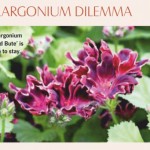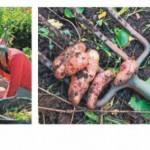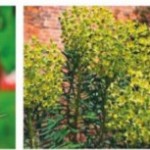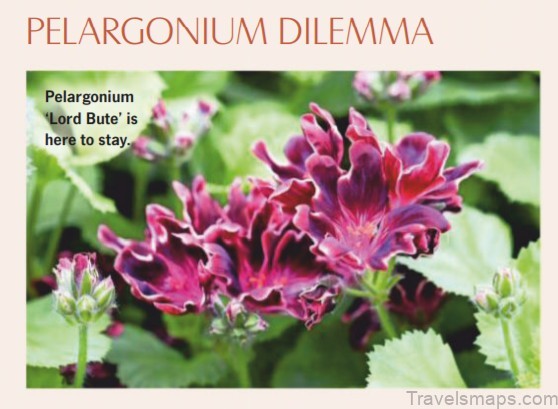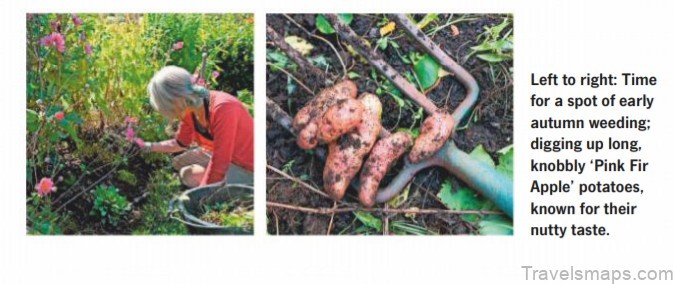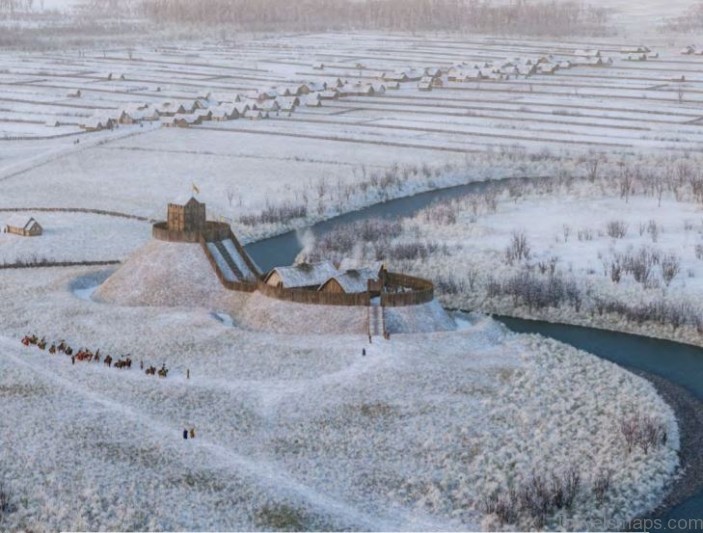
ON THIS STILL day out in the garden, I can hear the gentle thud of falling apples: there is a good crop this year. From the driveway, occasional tinkling sounds signal conkers hitting cars parked beneath the horse chestnut tree. Squirrels are busy burying this bounty. I will be intrigued to see where new seedlings come up next year. Colourful show Fuchsias perk up as nights cool and there is more moisture in the air. Every other year or so, I buy a small selection of hardy and tender rooted cuttings from specialist nurseries.
While Fuchsia excorticata and the trailing F. procumbens are New Zealand natives, most species fuchsias come from various parts of South America. Hardier fuchsias include the familiar scarlet and purple flowered F. magellanica, which reminds me of autumnal Cornish gardens, where it grows abundantly. I like the elegant white flowers, tipped with green, of ‘Hawkshead’: unfortunately, it was too dry in the wood bed, and it expired. Small-flowered ‘Lady Bacon’ has made a woody old stem, but is planted near a hedge which harbours capsid bugs, and the flowers are consequently often sparse.
The garden in September Photo Gallery
This winter, I kept a few fuchsias in an unheated greenhouse. Temperatures did not drop below -5°C, and all of them came through. Trailing ‘Tom West’ has variegated pink, cream and green leaves, punctuated by dark purple and pink flowers. While said to be hardy, I have lost it in the past. ‘Wapenveld’s Bloei’ is an upright grower, with clusters of small, ‘starry’, two-toned pink flowers, reminiscent of one of its parents; the tender Fuchsia arborescens from Mexico. ‘Bland’s New Striped’ has deep pink sepals, and its purple skirts, or corolla, are brushed with pink. This one is an oldie, dating back to 1872.
‘Lye’s Unique’ is in flower for most of the year and is cosseted in the conservatory over winter. The flowers are a crisp cream, with neat, dark coral skirts. Another of the old Victorian cultivars, it too has stood the test of time. I have yet to try the fuchsia berries I have heard so much about. I have seen Fuchsia boliviana quoted as being top for flavour. It is an eye-catching, tender fuchsia, particularly ‘Alba’, with its clusters of long white tubular flowers and scarlet corolla.
Maybe this is one for me to try next year. In the copse We are overrun with ground elder. As autumn rains loosen the earth, I shall start weeding again in the wild plum and hazel copse. I always wonder how an introduced pot-herb could have spread itself so widely. Last September, I started planting this dry, shady area. The aim is to achieve a balance between native plants and incomers. It is very much a work in progress. Great rustling swathes of pendulous sedge, which provide evergreen solidity, have been retained and tamed. More ferns have been added.
I liked the delicate effect of the native wood spurge, Euphorbia amygdaloides, in spring. I am told it will seed around. A more permanent alternative needs to be found for the huge-leaved biennial Angelica archangelica that currently fronts the entrance. For the other side of the path, I am still mulling over airy non-native shrubs that could complement this woodsy space. Later crop I always seem to be later harvesting my first tomatoes than most. I have started to cut the foliage back now to expose the ripening fruits to maximum light, especially on the larger beefsteak types, which take longer to mature. I am also digging up the last of the ‘Pink Fir Apple’ potatoes. To prevent weeds taking hold during the winter, I will put down straw-based mulch on the raised bed where they have been.
The number of pelargoniums I have at the moment is getting out of hand, and space to overwinter cuttings and parent plants is limited. While professional growers cut back parent plants hard for the winter, I like to keep a display going. But, if I am honest, I do not like some of them much anyway. So, which will be going on the compost heap? Regal pelargonium ‘Aztec’ has white ruffled flowers, with raspberry centres: it seems less robust in growth than the similar blackcurrant-centred ‘Cezanne’. ‘Apple Blossom Rosebud’ is an old Victorian zonal cultivar, and its doubled flowers look cramped to me: pale pink ‘Millfield Rose’ is prettier.
I am not convinced that the lime- and green-leaved ‘Crystal Palace Gem’ is worth keeping, but the crackle-effect, ivy-leaved ‘Crocodile’ might stay. ‘Marchioness of Bute’ was intended to partner the sumptuous single ‘Lord Bute’, but her doubled, rumpled, flattish, deep purple flowers, edged with white, are not worth it. This rather leggy plant seemed to be the source of most of the pests in the conservatory last winter. Lady, it is time to go. Before damp and rain spoil the petals, the remaining parent ‘pellys’ will be brought into the small greenhouse, where I can enjoy them for a little longer. They will then be tidied and moved into the conservatory.
Maybe You Like Them Too
- The Best Places To Visit In North America For Christmas
- Faro Travel Guide: Map of Faro
- Mumbai Travel Guide For Tourists: Map Of Mumbai
- Travel to Budapest
- Thailand Travel Guide for Tourists: The Ultimate Thailand Map

